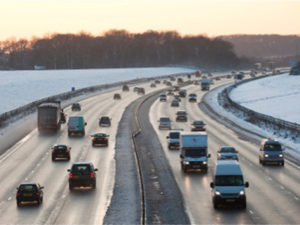Drivers putting themselves in danger during motorway breakdowns
The RAC has created a new video to help keep drivers safe during motorway breakdowns as it warns that nearly eight in 10 (78%) drivers would unknowingly put themselves in danger.

Only a fifth (22%) of drivers would do the right thing after breaking down on a motorway
New research by the automotive services specialist has found that only a fifth (22%) of the 1,900 drivers surveyed would do the right thing after breaking down on the motorway and stopping on the hard shoulder by standing to the rear of their vehicle and as far as possible from traffic, ideally behind a barrier if there was one.
Frighteningly, one in 10 (11%) said they would stay in their vehicle, leaving them at great risk of being seriously injured or killed if another vehicle were to hit them.
Two-thirds (65%) would also unwittingly put themselves at risk by standing either in front of or next to their car, where they could be hit in the event of another driver colliding with their broken-down vehicle.
The analysis corresponds with reports from nearly 200 RAC patrols, who found 78% of drivers they have attended who had broken down on motorways were still in their vehicles when they arrived.
The RAC’s new video, originated by patrols Glen Johnson and James Pallister, highlights exactly how people should get out of their vehicles and where they should stand.
James Pallister, who has been an RAC patrol since 2015 and works around the North East of England, said: “Increasingly, when we arrive at the scene of a motorway breakdown we find members still inside their vehicles, or stood next to or in front of them – two of the most dangerous places to be with vehicles approaching at fast speeds.
“Instead, our advice to drivers and their passengers is to use the doors furthest from the traffic to leave their vehicle, stand to the rear of their vehicle, facing and as far away from oncoming traffic as possible, behind a barrier if there is one. The only exception to this is if someone has mobility difficulties and can’t easily leave the vehicle – in which case they should keep their seatbelt on and call 999.”
RAC Breakdown spokesperson Alice Simpson added: “The more understanding everyone has of what to do should they break down on a high-speed road, the better. We hope the safety advice video that our patrols James and Glen have made will keep more drivers safe in the event of a motorway breakdown.
“While it’s important those breaking down take the right steps to keep safe, it is also vital that breakdown and recovery operators are protected from potential collisions from passing traffic. For this reason, we are pleased the Government is finally going to allow the industry to use red flashing lights, in addition to the customary amber ones, after years of campaigning from the RAC and others. We believe this will save the lives of both breakdown workers and their customers, so we are now very keen for the Government to confirm when these powers will be formally granted.”
The RAC’s video is here while further advice on what to do in the event of a motorway breakdown is available here.
New Blue Light Aware campaign to keep drivers safe and legal
Gem Motoring Assist is running its latest campaign to help keep drivers safe on the roads when making way for emergency vehicles.
The campaign uses the ‘Blue Light Aware’ suite of short video animations, providing straightforward advice on what to do and what not to do when helping an emergency vehicle.
The videos, approved by experts from the emergency services, include specific locations such as traffic light junctions, roundabouts, motorways without hard shoulders and stretches of road with solid white lines where overtaking is not allowed.
Gem road safety adviser James Luckhurst said: “Every driver wants to help and do the right thing, but the approach of a blue light vehicle can take them by surprise. In the dark days of winter, with poor weather often making journeys more difficult, we’re keen to prevent additional danger caused by drivers who may be unsure of what they’re expected to do.
“Our videos are designed to minimise confusion and reduce risk, which in turn could save vital seconds for blue light vehicles responding to emergencies.”
The campaign’s Blue Light Aware resources are here.












